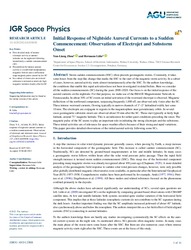Initial Response of Nightside Auroral Currents to a Sudden Commencement: Observations of Electrojet and Substorm Onset
DOI: https://doi.org/10.1029/2021JA030050
Persistent URL: http://resolver.sub.uni-goettingen.de/purl?gldocs-11858/10281
Persistent URL: http://resolver.sub.uni-goettingen.de/purl?gldocs-11858/10281
Zhou, Yun‐Liang; Lühr, Hermann, 2022: Initial Response of Nightside Auroral Currents to a Sudden Commencement: Observations of Electrojet and Substorm Onset. In: Journal of Geophysical Research: Space Physics, Band 127, 4, DOI: 10.1029/2021JA030050.
 |
Dokument öffnen: |
Storm sudden commencements (SSC) often precede geomagnetic storms. Commonly, it takes some hours from the step‐like change that marks the SSC to the start of the magnetic storm activity. In a subset of cases, however, auroral activity starts almost instantaneously after the SSC. To the authors knowledge, the conditions that enable this rapid activation have not been investigated in detail before. Here we consider all the sudden commencements (SC) during the years 2000–2020. Our focus is on the initial response of the auroral currents on the nightside. For that purpose, we make use of the IMAGE Magnetometer Network in Fennoscandia. In about 30% of SC events an initial activation of the westward electrojet is observed. Magnetic deflections of the northward component, surpassing frequently 1,000 nT, are observed only 4 min after the SC. These intense westward currents, flowing typically in narrow channels of 1°–2° latitudinal width, last some 10 min. The electrojets are conjugate to regions in the magnetosphere near geostationary orbits. In several cases geomagnetic substorm onsets are observed about 30 min after the SC. These start typically at fairly high latitude, around 71° magnetic latitude. This is an indication for rather quiet conditions preceding the onset. The magnetic pulse of the SC seems to play an important role in initiating the strong electrojets and the substorms. These initial activities are of relevance for space weather effects because of their strong and rapid variations. This paper provides detailed observations of the initial auroral activity following some SCs. Key Points:
First detailed study of intense electrojet activity at auroral latitudes on the nightside following immediately a sudden commencement (SC).
Precondition for intense auroral activity is a southward interplanetary magnetic field Bz and a sufficiently large magnetic pulse caused by the SC.
In a subset of events also an isolated substorm is initiated at relatively high magnetic latitudes shortly after the SC.
Statistik:
ZugriffsstatistikSammlung:
This is an open access article under the terms of the Creative Commons Attribution License, which permits use, distribution and reproduction in any medium, provided the original work is properly cited.

